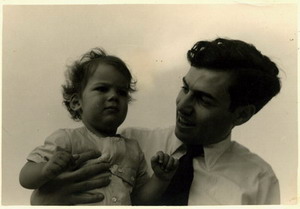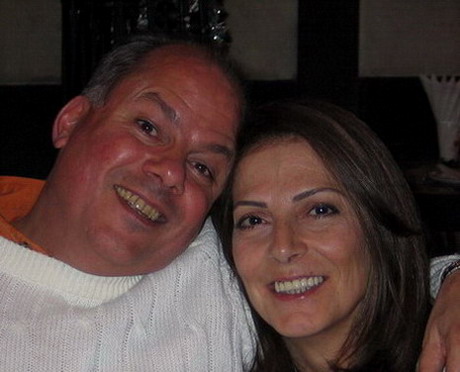On Thursday 26th April I had an opportunity to travel to the south of Lebanon with Nassib Solh, the managing Director of Al Amal Institute for the Disabled. I wanted to learn more about their activities for the festival that they have been holding every year for the past 5 years. I also wanted to take the opportunity to tour the area and see the damage the Israelis wreaked on that part of the country at first hand, even though it has been approximately 8 months since the end of the war.
Travelling with us were Marie-Claude Fleyfel, a French/Canadian peace activist, and her husband Mohamed, my mother-in-law Naimy, and Adnan, one of the persons with special needs resident at Al Amal.
Travelling with us were Marie-Claude Fleyfel, a French/Canadian peace activist, and her husband Mohamed, my mother-in-law Naimy, and Adnan, one of the persons with special needs resident at Al Amal.
We started off from Brummana at around 11:00, headed to Beirut where we dropped off some produce packages that Al Amal give to donors through a telemarketing company in Beirut, then we headed south.
(Click on the pictures to enlarge)
The journey took us through Saida, on the highway that is still littered with detours where bridges where bombed. Some bridges have been repaired, such as the Khalde and Damour bridges, however some of the major bridges are still undergoing reconstruction.
At Zahrani we got off the coastal highway heading towards Nabatiye. Zahrani is where a power station, a refinery and the highway bridge, all within viewing distance from each other, were bombed.
Just after Nabatiye we forked off into a minor road heading towards Arnoun. Nabatiye suffered some major damage during last July’s war with many houses and businesses destroyed.
At Zahrani we got off the coastal highway heading towards Nabatiye. Zahrani is where a power station, a refinery and the highway bridge, all within viewing distance from each other, were bombed.
Just after Nabatiye we forked off into a minor road heading towards Arnoun. Nabatiye suffered some major damage during last July’s war with many houses and businesses destroyed.
Arnoun sits at the foothills of Beaufort Castle, about 1 km east of the Litani river on the other side of the ridge where the castle stands, and about 3 km north of the Litani where the river makes a 90° turn East heading towards the Mediterranean. We now entered the area that had been under Israeli occupation from 1982 to 2000.
Arnoun
Beaufort Castle, a fort built during the Crusades, occupied by the Israelis 1982 - 2000 where they built a bunker right next to the castle exposing it to attack by the resistance. The bunkers are still there.
Arnoun is also the location where Al Amal hold their annual festival in July and August. They erect tents, have camp fire songs, folklore dances, and other activities. They are visited by local scouts, army officials, artists, mayors, union officials etc. The serious side of this festival though is the harvesting of wheat and tobacco, and cracking of wheat into “burghol”. I’ll be writing in more detail about this in the “Sweater and Wheat” blog for Al Amal.
The land where the festival is held. The posts outline the large tent that is erected during the festival.
During the festival the organizers and participants stay in the school at Arnoun. This school had some superficial damage and its windows shattered during the war. It was refurbished with a donation from the UAE.
The school at Arnoun. The posters warn of the dangers of cluster bombs.
One of the teachers there lives in Yuhmur, 3 km south of Arnoun, not far north of the Litani river. He took us on a tour of that village.
The Israelis destroyed 60% of the houses and businesses in Yuhmur during the war. On the eastern side of Yuhmur lie 3 hills. During the war the Israelis repeatedly tried to occupy those three hills. They were driven back each time. They eventually managed to occupy one of the hills, but came under constant resistance fire from the Yuhmur area leading to the Israeli air force repeatedly raiding and bombing Yuhmur causing terrible damage and destruction.
Foundations where houses once stood
Reconstruction ongoing
On our way out from Yuhmur we came across a convoy from the Mine Advisory Group (MAG). We stopped to have a chat with their commander. MAG is a humanitarian volunteer Non Government Organization (NGO) specializing in clearing up the remnants of conflict, mostly in poor, third world countries. The unit we spoke to were all Lebanese. Their commander informed us that they have completed phase one of the operation to clear some of the millions of cluster bombs that were dropped by Israel in the south in the last couple of days of the war. Phase 1 is clearing the bombs from people’s backyards and along the sides of roads. Phase 2 is locating and clearing the mines in fields, farms and remote areas.
The MAG vehicles and how areas are marked in preparation to remove cluster bombs.
From Yuhmur we then drove further south towards Kfar Kila and “Bawabet Fatmeh”, (Fatmeh’s Gate). This is right on the Lebanese/Israeli border, across the hill from the Israeli settlement town of Mtalleh, or Matulla as the Israelis call it. We drove on the road parallel to the electrified fence marking the border. I was in this area back in 2000 just 4 months after the liberation of the south, and at that time there was an actual gate there, and Israeli fortified positions across the fence that kids from the Lebanese side were throwing stones at. The road that runs along the fence for a couple of kilometers was busy with people and stalls. Now the gate is gone, or at least I didn’t see it there any more, the fortifications seemed abandoned, the road was empty the stalls are gone, the place was eerily quiet.
Kfar Kila in 2000, just after the liberation of the South. The area was bustling and children were throwing stones at Israeli fortifications. The middle picture shows a mock Katyusha launcher and the sign says "If you came back we'll return", an obvious warning to Israel!
The Israel settlement of Mtalle in 2000
2007 - The Lebanese/Israeli border now lined with multiple fencing, some of them electrified. And the Israeli settlement of Mtalle, apparantly still evacuated.
From Kfar Kila we then drove through Al Marj, where the Israelis lost 6 tanks and 2 bulldozers in the muddy waters that cover this area, towards Al Khiyam.
The road across Al Marj. The water bogs can be seen where some Israeli tanks met their fate. The roads runs just a few meters from the Israeli border and the Israeli settlement of Mtalle.
Al Khiyam is a large village about 5 km from the Israeli border. It sits at an altitude of 750m. It is where the notorious Al Khiyam prison is located.
Al Khiyam
The prison is located just outside of the town on a strategic hill. On a clear day you can see Mount Hermon (Jabal Al Sheikh), Chebaa Farms, and the Golan Heights from there. You can also see far into Israel. On the day we travelled to the south the weather was very hazy. It’s the season of the “Khamseeniat”, (the fifties in Arabic). This is the time of year when sand storms in the Sahara and Egypt kick up enough sand and dust sending them all the way across the Lavent.
The murky weather prevented us enjoying a magical view
During the occupation this prison was used by the Israelis and the South Lebanese Army allied to Israel at the time to torture resistance suspects and collaborators and agents. Many people died there from the torture. When the Israelis hurriedly withdrew from the south they did this overnight, abandoning the prison and their allies the SLA, under cover of darkness. They wanted to demolish the prison, but because the prisoners where still there they were unable to. Last summer’s war gave them the opportunity to do so, and through repeated air raids and bombing they finally managed to level the prison in an effort to remove a shameful stain on the history of their occupation of the south.
Al Khiyam prison back in September 2000 just after liberation
The names of those who died in the prison through torture and those who died following release after the Israelis departed
Al Khiyam prison in April 2007 after the Israeli aggretion on Lebanon
During the bombing of the prison the Israelis also destroyed 360 houses in Al Khiyam, just for the heck of it. Everywhere you go in this town there are people working on repairing their houses. Al Khiyam is one of the two villages that Qatar is donating funds to help rebuild, the other one is Bint Jbeil.
It was now getting dark and time to head back along the 100 km to Beirut. On the way back we went through Marjaayoun, driving past the infamous Army barracks where the Israelis went to take cover from the resistance fighters chasing after them, and ended up being invited to drink tea with the commanding officer.
We stopped for a bite to eat at Al Qlaiaa, another of the villages that was heavily bombed by the Israelis, and then headed back home. We arrived back in Brummana at around 10 pm.
A late lunch at Mario's restaurant in Qlaiaa
This was a thoroughly enjoyable and informative trip, sometimes shocking, sometimes tragic, but well worth it. Anyone wanting to see the vindictive and destructive damage the Israelis caused at first hand and hear stories of heroic resistance of the people of the south should go there. It is relatively easy to get there, have your documents with you because you will go through many checkpoints. All the checkpoints are manned by the Lebanese Army who are very courteous and helpful.

The area toured.



























































































5 comments:
Thank you for sharing that, Sams. It is difficult to see first hand (or second hand, whatever the case may be), but I appreciate the opportunity you've provided to keep us well-informed.
thouroughly enjoyed your adventure down south...
Interesting, Sarmad -
Mine clearance could go on for years, couldn't it? We don't hear the same number of stories about kids being killed by them, so either the news doesn't cover it, or the kids are more informed, or perhaps the clearance is proving effective.
The pictures really help to clarify the situation there.
I have been listening to the recent Israeli judgements on the invasion and at the moment I wonder whether they feel the whole thing was a mistake or just that they should have won the battle. So difficult to read between the lines.
Thanks for all your efforts to keep us in the loop.
very interesting piece - thank you
Good for people to know.
Post a Comment